As a traffic or construction facility, you know during road construction, maintenance work, or utility repairs, lanes are typically closed, and routes diverted. This sudden change creates confusion to drivers who are used to regular road layouts. This is where you should use arrow boards to address drivers confusion issues and roadway chaos in temporary traffic control zones.
But these arrow boards come in different types to cater to different use cases. Therefore, it is important for facilities to deeply understand arrow boards, their types, their regulations, applications, and much more. And that’s exactly what we’ve explained for you in this guide.
What is an Arrow Board?
An arrow board (often known as directional arrow signs, traffic arrow panels, flashing arrow signs, LED arrow boards, traffic control boards, variable message arrow boards, arrow panel signs) is an electronic traffic control device. Typically, this consists of a large panel with LEDs mounted on it. These LEDs flash or stay steady in different arrow patterns to guide traffic.
You’ll mostly see them on highways, work zones, accident roads, or behind slow-moving vehicles. Their job is simple: flash a light in a certain pattern to alert people on the road about a potential hazard. And via a certain arrow pattern display, they guide drivers where to go (like merge left, right, or drive slowly). This helps reduce drivers’ confusion, control traffic flow, and reduce accident risks.
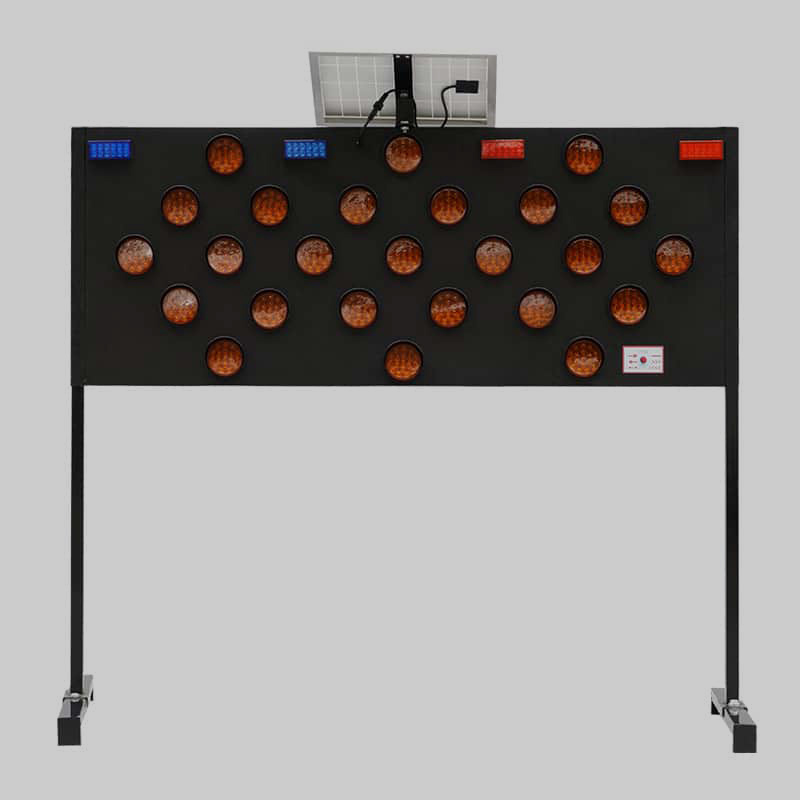
Meaning of a Flashing Arrow Board
If we talk about this, an arrow board simply means there’s a temporary change in a road ahead, in terms of either construction, repair work or accident. These boards flash an arrow in different patterns or display symbols (according to the different road situations), to alert traffic and redirect them to a safe router.
Let’s take an example, suppose you’re driving on a highway. And suddenly you notice a big electronic sign with a flashing arrow pointing left. That’s your signal to safely merge into the left lane because the right lane might be closed ahead. If you ignore it, you could put yourself or workers at risk.
Key Features of Modern Arrow Boards
- Bright and highly visible LED lights
- There are many caution and arrow pattern options.
- Different power options like solar-powered, battery, etc.
- Remote control operation for easy management.
- Weather-resistant and durable build
- Lightweight and easy to transport
- Adjustable brightness levels
- Can be mounted on vehicles, trailers, walls, etc.
- Low maintenance requirements
Different Types of Arrow Boards
Arrow boards come in a variety of types across different mounting options, power sources, functionalities, and key features. And the kind of arrow board you choose will entirely depend on the underlying environmental condition. Below, we’ve explained all the types of arrow boards (based on functionalities):
-
Portable Arrow Boards
Whenever you need a portable moving setup to redirect traffic, portable arrow boards are a great choice. They are compact, lightweight, can be moved around easily, adjustable (for visibility), and have a sturdy wheel for stability.
You’ll typically see them at temporary work zones, short-term detours, or events where traffic needs quick redirection for some hours. Since they’re not fixed to a vehicle or trailer, they are easy to set up and pack up.

-
Vehicle-Mounted Arrow Boards
Vehicle mounted arrow boards, on the other hand, are basically a moving electronic-sign. You can install them on the back of your work vehicle (either permanently or temporarily). And when you move the vehicle, the arrow pattern or message on the arrow board, alert approaching drivers to slow down or merge.
You can use them on the back of any work vehicle like construction trucks, maintenance vans, or utility trucks. These models’ boards are commonly used on high-speed areas like highways where vehicles are passing at high speeds.
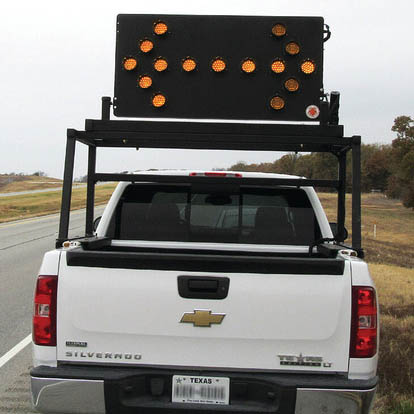
-
Solar-Powered Arrow Boards
As the name says, these arrow boards are powered by solar plates and have rechargeable batteries for backup. In the daytime, they operate using sunlight. And in the nighttime, they use the energy stored in the battery.
You can use them for long-term projects, especially in areas where power outage is a common issue. They’re eco-friendly, cost-effective solutions, super reliable, durable, have long battery life, and require less maintenance.
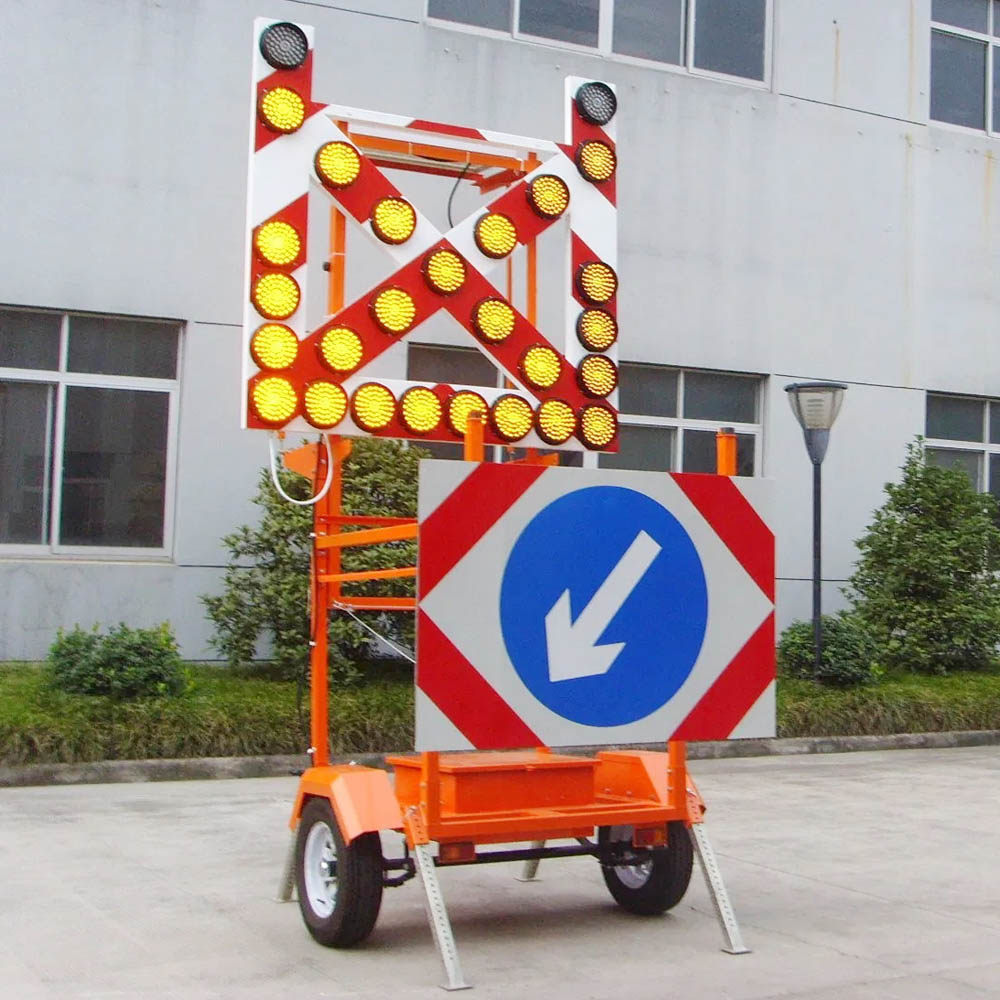
-
Trailer-Mounted Arrow Boards
These arrow boards are fixed on trailers. Means, you can easily tow them to different job sites, and position (wherever needed). They have sturdy wheels, stay stable, have adjustable height capability, and are high-visible even from long distances.
You can use them on highways, big construction sites, or areas with heavy traffic redirection. Since they’re often solar-powered, so you can also place them on the road for as long as you want. Because they operate through sunlight and keep guiding traffic consistently.

-
LED Arrow Boards
If we talk about these, then in their older models, light bulbs were used in arrow boards. These bulbs were very hard to see in daytime. So, in the latest model of arrow boards (like portable, trailer-mounted, or vehicle-mounted), high-quality LEDs are used. They are large, save energy, last longer, illuminated, highly-visible and give drivers a clear and sharp visual signal.

MUTCD Defined Types of Arrow Boards
The Manual on Uniform Traffic Control Devices (MUTCD) has classified traffic arrow boards in three types: Type A, Type B, Type C, and Type D (based on their size, display pattern, and function).
What is a Type A Arrow Board?
Arrow board Type A is a small, compact arrow board and is designed for use in low-speed areas (where the speed limit is under 45 mph). You’ll mostly see them during short-term or minor maintenance work. They’re lightweight, often portable, easy to set up, and bright enough to catch the driver’s attention, alert, and guide them.
What is a Type B Arrow Board?
Arrow board Type B, on the other hand, are larger than Type A, designed for mid-speed roads (where speed limit is between 45–60 mph). You’ll mostly see them on mid-level traffic zones such as busy city roads or smaller highways. They provide better visibility (even from a far distance), often mounted on trailers or work vehicles.
What is a Type C Arrow Board?
Type C arrow boards are solid-rectangular big structures, highly visible, and designed for high-speed roadways (where traffic goes over 60 mph). These boards are usually trailer-mounted and hence, you need to place them in advance, so drivers have time to react. They’re perfect for long-term projects or major lane closures.
What is a Type D Arrow Board?
Unlike the others, arrow board Type D are designed for use on vehicles that are authorized by law enforcement or government authorities. Plus, they face both directions, front or back. These are mostly used in mobile operations where the vehicle is always moving.
Type A vs Type B vs Type C vs Type D (Comparison Table)
| Feature | Type A (Small) | Type B (Medium) | Type C (Large) | Type D (Special Purpose) |
| Minimum Size of Arrow Length and Arrowhead | 48 x 24 inches | 60 x 30 inches | 96 x 48 inches | custom sizes |
| Typical Use | Low-speed urban streets, local roads | High-speed highways, major arterials | Freeways, expressways (long-distance visibility) | Unique scenarios (e.g., reversible lanes, complex merges) |
| Arrow Display | Flashing or sequential arrows | Steady, flashing, or sequential arrows | Dynamic arrows (often sequential for high-speed guidance) | Custom (e.g., bidirectional arrows, chevrons, text) |
| Speed Suitability | Low speeds (< 45 mph) | Moderate to high speeds (45–60 mph) | High speeds (> 60 mph) | Depends on configuration |
| Placement | Close to drivers (½ mile) | Intermediate distance (¾ mile) | Far visibility (1 mile) | Typically ½ mile |
| Common Applications | Lane shifts in work zones, urban detours | Highway lane closures, temporary diversions | Major freeway lane closures, long-term work zones | Complex traffic control, special events, toll plazas |
| Visibility | Lower intensity | Moderate to high intensity | High intensity (long-range visibility) | Adjustable based on need |
Working Principle of Arrow Board
Here is a clear explanation of how an arrow board works:
The big board is made up of a panel that contains 12-15 or more LED lights. These LED lights are designed in a way that when they are lit up, they display different arrow patterns. Such as straight arrows, flashing arrows or even bidirectional arrows.
Now, when there’s roadwork, a lane closure, or any kind of obstruction or emergency ahead, the traffic control operator takes action. They turn on the arrow board (either on the spot or in advance) and select the right arrow pattern (based on the situation).
For example, if the right lane is closed, they’ll choose a left-pointing arrow to warn traffic about a potential hazard ahead and guide them to safely move to the left. This way, the arrow board works in communicating with drivers, keeping traffic organized, and prevents road accidents.
What are the Sizes of Arrow Board?
Different arrow board manufacturers made arrow boards in different sizes. Because not every road or situation needs the same level of visibility. The following are the sizes of JACKWIN’s different arrow board types:
Truck Mounted Arrow Boards:
- Size 102x129cm
- Length 1650mm (as per Australian size A, US MUTCD type B and C standards)

Solar Powered Arrow Boards:
- Size 1200x400x60mm
- Size 1500x600x60mm
- Size 2320x2000x2770mm
- Size 1500x920mm
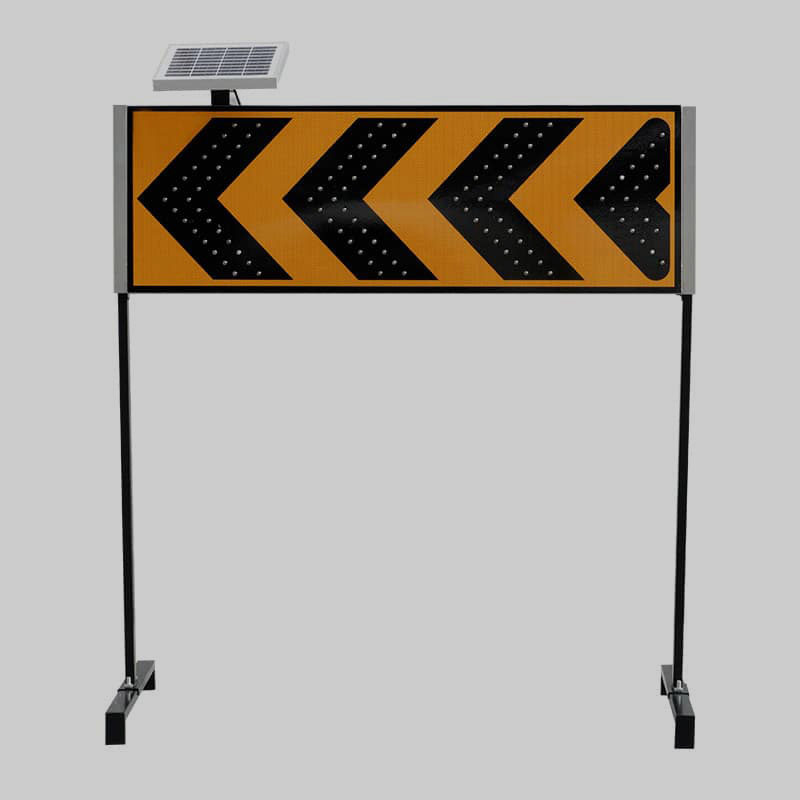
Vehicle Mounted Arrow Boards:
- Size 1410x365x85mm
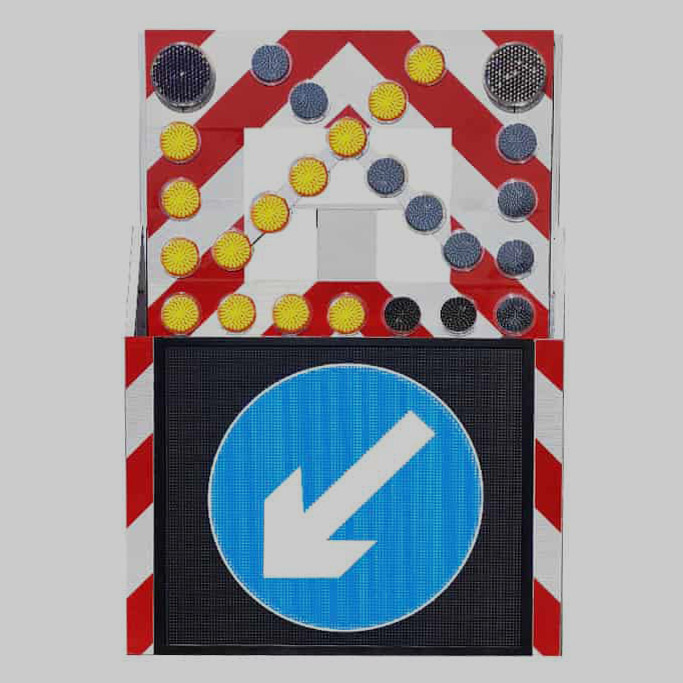
What is the Weight of an Arrow Board?
Well, the weight of an arrow board entirely depends on their designs. Like arrow board type, size, and how they’re designed to be mounted. Some are light enough to move around by hand, while others need proper mounting or towing equipment.
But if we talk generally, portable arrow boards are the lightest among all types. They typically weigh around 100 to 300 pounds. On the other hand, trailer-mounted arrow boards (like Type B or C) are much heavier. Including both board and trailer frame, they weigh around 500 to 1500 pounds or more (based on size).
On the contrary, vehicle-mounted boards weigh in between, like around 50–200 pounds. Because they’re lightweight and meant to be mounted on vehicles.
Arrow Boards Flashing Patterns Explained
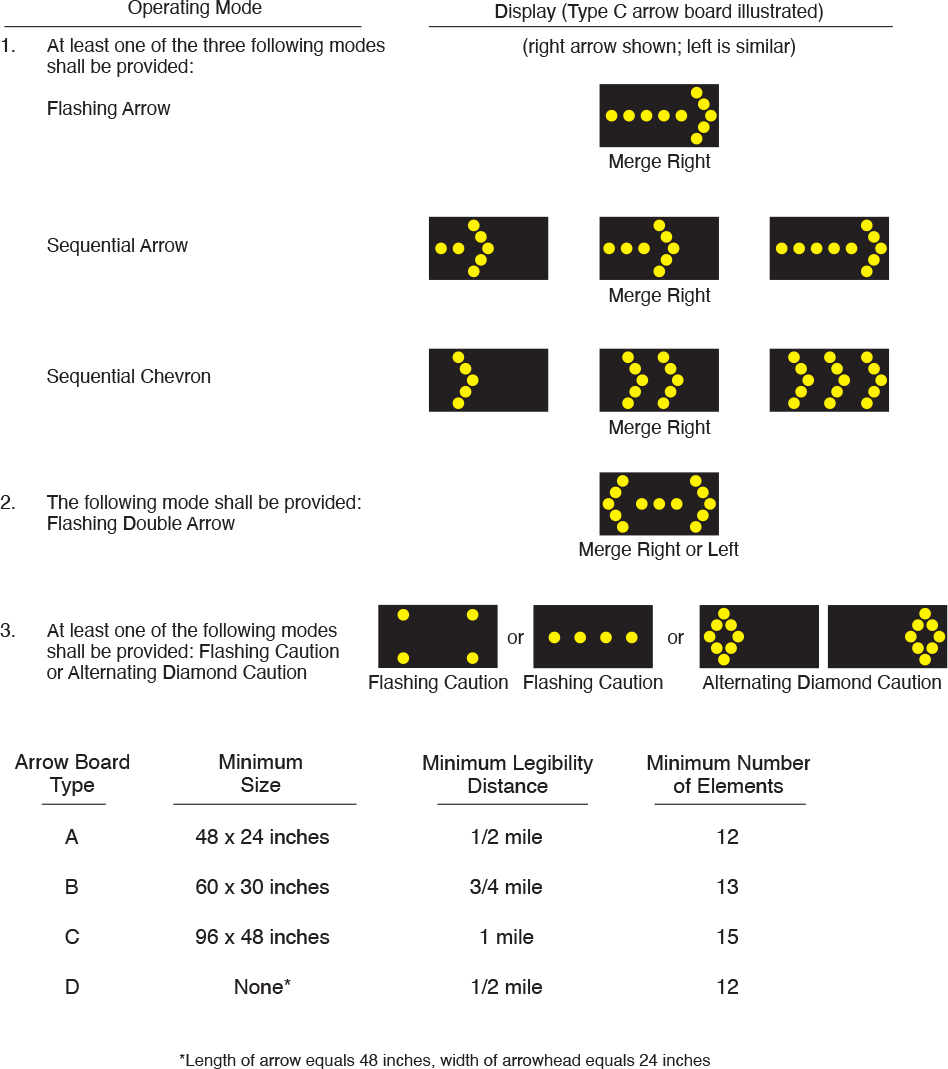
-
Steady (Non-Flashing) Arrow
Pattern: A single arrow pointing towards any direction.
Meaning: Driver should move in the same direction the arrow is pointing.
Use Case: Widely used in low-speed or controlled areas. Especially when a lane shift or merge is required.
How It Helps: Gives a clear direction to drivers from a distance. That way, drivers easily spot the steady signal and follow the same direction.
-
Sequential Flashing Arrows
Pattern: Arrows flashing in sequence in one chosen direction. Means, arrows light flashing one after another in one direction.
Meaning: Merge or shift in the direction of the flashing arrow.
Use Case: Common in lane closures on highways or expressways (where traffic is redirected).
How It Helps: The moving flash pattern catches attention quickly, guides drivers to move in the direction they need to move.
-
Simultaneous Flashing Arrows
Pattern: All lights of the arrow flash on and off at the same time.
Meaning: Drivers should move in the displayed direction.
Use Case: Often used in medium-speed work zones or intersections.
How It Helps: With its all arrows flashing at the same time, it reinforces drivers to move in the shown direction.
-
Alternating Flashing Arrows
Pattern: Two arrows (like left and right) flash back and forth, not at the same time.
Meaning: Direction change (like a two-way merge) or watch for caution.
Use Case: Commonly used in bidirectional work zones or where traffic must merge from both sides.
How It Helps: These signs guide drivers about lane merging ahead and warn of caution while driving.
-
Sequential Chevrons
Pattern: Chevron shapes (like >> or <<) flash, either simultaneously or sequentially.
Meaning: Warn drivers about sharp curves or lane shifts ahead.
Use Case: Facilities set up them in advance of a sharp lane shifts or major road curvature near work areas.
How It Helps: The chevron flow signs alert drivers in advance that there might be a lane shift or road curves ahead. So they should drive slowly and cautiously.
-
Flashing Caution Bar
Pattern: A straight horizontal line of lights flashes on and off.
Meaning: Caution ahead, so the driver should slow down.
Use Case: Generally installed before actual work zones begin, or in advance warning areas.
How It Helps: These caution signs tell the driver in advance that something is coming their way ahead. So they should prepare, slow down, and stay alert.
Traffic Control Regulatory Standards For Arrow Boards
The FHWA, ATSSA, DOT, and other traffic authorities designed a few standards and regulations for arrow boards that every facility is required to follow in order to use arrow boards on public roads and other places. Therefore, it’s important for you to learn about all those regulations. Here’s what they include:
- Must withstand harsh weather conditions (like operating in rain, wind ≥40 mph, and temperatures from -30°F to +130°F).
- Must have bright LEDs and clearly visible from at least 1/2 mile (800 meters) in daylight.
- Set up 7 feet above ground for optimal visibility (except vehicle-mounted arrow boards).
- Must be positioned ahead of work zones (exact distance depends on road speed).
- Should be placed in a clear spot so that they don’t obstruct the driver’s sight or other traffic signs.
- Must have a backup power source (battery or generator) in case of failure.
- Facilities should turn them off or dim when not in use to avoid confusion.
- The minimum on-time period for flashing mode should be 50 percent, with 25 percent for each sequential period in equal intervals. The flashing time shouldn’t be more than 40 flashes/ minute or less than 25 or more.
- Arrow board chevron mode should only be used when there’s a moving or stationary lane closure.
- For roadside work or the temporary closing of one lane in a one-way or two-way roadway, a caution mode sign should be used on arrow boards.
- If you need to close multiple lanes, use a separate arrow board for each closed lane.
- They must be regularly inspected for damage or malfunction.
How to Install Arrow Boards?
In the market, you’ll find arrow boards in different mounting options, too. So the installation method of your arrow board depends on the arrow board unit you have chosen. Let’s first go through the installation methods:
Installation Methods for Arrow Boards
- Vehicle-Mounted:
For this method, you need to use vehicle mounted arrow boards. Because these arrow boards are specifically designed to be installed on the back of your work or maintenance vehicle (using permanent or adjustable frame).
- Trailer-Mounted:
You’ll get a separate built-in trailer with your trailer-mounted arrow boards. That lets you tow the arrow board with a trailer and park at the site. No heavy installation needed, just position it and secure the wheels.
- Portable Stand-Alone Units:
Well, in this, you set up your arrow board on any foldable stands or any strong support. And you can then move the board easily and place it wherever needed.
- Fixed-Mount Boards:
If you want to permanently install arrow boards for your long-term project, this method is ideal. You can install them in a permanent position on overhead gantries or poles on roads and highways.
Steps to Set Up Arrow Boards
- Firstly, check the arrow board condition thoroughly. Like inspecting the unit battery, LED bulbs and other components to ensure that the unit is working fine.
- Next, place the arrow board on the car or your transportation vehicle and deliver the unit at the site (where you need to install).
- Once you reach the site, now is the time to install the arrow board. If it’s a trailer-mounted or portable arrow board, then use wheel chocks or stabilizers and stabilize the board. If it’s a vehicle-mounted board, then install it at the back of the vehicle, authorized by the government.
- Once the arrow board is installed and stable, turn on the board via the control panel. Your unit might be wired inside the vehicle or operable with a remote (depending on the model).
- Now, choose the correct arrow or warning pattern for the situation. For example, use a left arrow if traffic needs to move left, use a right arrow if the lane on the right is open, use a caution bar if drivers just need to slow down and stay alert.
- Walk a few steps back or drive past and see yourself if the message or arrow is clearly visible (especially from a distance). If not, adjust the angle or height.
- Once it’s live, we suggest you don’t forget to monitor traffic. If the situation changes, immediately update the board’s message or arrow pattern to avoid confusion.
Benefits of Using Arrow Boards on Roads
- Clear Guidance for Drivers
When there’s a sudden change on the road, like lane closures or diversions, it causes drivers confusion. Here, the arrow board visually alerts them from a far distance with its bright LEDs. That guides them about a potential hazard ahead and tells them where they should go next.
- Reduces the Risk of Accidents
Since arrow boards guide drivers about lane closures or construction work ahead, this scenario acts like a warning before the warning. That way, drivers have enough time to slow down or change lanes safely.
- Improves Work Zone Safety
As arrow boards redirect traffic to a safe path, this helps protect the lives of workers on-site.
- Works in All Light Conditions
Arrow boards come with high-brightness LEDs. So they stay visible in broad daylight, pitch-dark nights, rain, fog, or dust and continue to warn and guide traffic (regardless of environment changes).
- Quick Setup, Big Impact
You don’t need any special tools or hire any technician. Just place the arrow board, secure it, turn it on, choose an arrow pattern, and that’s it.
- Flexible for Any Situation
Whether you need to close one lane, shift traffic left/ right, or just warn drivers of hazards ahead in their way, these arrow boards are an all-in-one solution. Even if there is a power outage issue at the site, using solar-powered arrow boards can do the job for you.
Common Applications of Arrow Boards Across Industries
| Industry/Area | How Arrow Boards Are Used |
| Road Construction | To manage vehicles around construction zones, show lane closures, and keep workers safe. |
| Traffic Control | Traffic management professionals set them up during detours, emergencies, or public events to control vehicle movement. |
| Utility Maintenance | Helps in redirecting traffic around electric, water, or telecom repair sites to avoid confusion or accidents. |
| Airport Runways | Facilities use them during runway maintenance or taxiway closures to give clear directional guidance to ground vehicles. |
| Event Management | Used to manage entry/exit routes, redirect traffic flow, and prevent road chaos, especially during concerts or large community events. |
| Mining & Industrial Zones | Used to manage traffic around the site and alert drivers to restricted or active operation zones. |
| Railway & Bridge Work | Used to give visual alerts during repair or inspection work to avoid mishaps and guide detour traffic. |
Our Tips for Arrow Boards Maintenance and Safety Considerations
Well, if we start from maintenance tips, then the first thing you must ensure is that the arrow board’s LEDs are working properly. Because a single dead light can confuse drivers or mess up the entire pattern. You should also regularly clean the panels as over time, dust or road grit builds up over LEDs, which fades their brightness.
In addition, we suggest you choose the correct type of arrow boards that suits best to the environment and traffic needs. Plus, whether your arrow board is vehicle-mounted or trailer-based, you must inspect and ensure every bolt, bracket, or arm is tight and stable.
Now, as per safety considerations, we would say that you should always choose the arrow pattern that matches the road or site situation. Because wrong arrow = wrong direction = danger. Plus, set the board where it’s easy to see, but never where it blocks other road signs. Lastly, keep someone on-site for regular inspection to monitor traffic and update the board (if conditions change).
What is the Price of Arrow Board?
The arrow board cost range differentiates between units (based on their type, size, and key features). If we talk generally, then the portable arrow board’s price range starts from around $1,500 to $3,000. Trailer-mounted or solar-powered arrow boards range from $4,000 to $8,000. And if you choose vehicle-mounted or custom-made arrow boards, the price will increase
Keep in mind that the price also varies between arrow board brands and suppliers. But if you purchase in bulk from a wholesale supplier like Jackwin, you will get high-quality arrow boards at affordable rates.
Best Arrow Board Manufacturer
Now, if you’re looking for the best arrow board manufacturer that provides high-quality units, that too at affordable prices, then JACKWIN is the best choice for you. Jackwin has been manufacturing road, traffic and parking safety products since 2008 across 50+ countries.
Jackwin manufactures and supplies different types of arrow boards across various sizes, standard, functions and mounting methods that meet all local and international standards (MUTCD and EN12352, EN60529, EN50293 & EN61000).
Whether there is a need for arrow boards for events, construction sites, or traffic control, JACKWIN is the leading and trusted factory by professionals. Plus, well-known for affordable and high-quality traffic safety products. Our experienced team can also customize functions of your arrow boards.
Future Trends in Arrow Board Technology
Innovations on Arrow Boards Structure and System
Soon, arrow boards will be connected to central traffic control systems. This means you won’t need to assign an operator on-site, and you’ll be able to update arrow patterns remotely (using a computer or even a mobile app). Also, facilities are looking for new materials that can withstand every weather and traffic condition for more durability
Dynamic Messaging System
Future boards may have a dynamic messaging system. These displays will provide more options to short messages, text customizations and animations. Researchers are also working to embed any imaging system to arrow boards for guidance through images. These advancements help make communication even more clearer for drivers.
AI Integration for Enhanced Traffic Control
In the future, arrow boards will be integrated with AI and ML. AI then analyzes traffic flow and adjusts arrow patterns in real time and reduces traffic confusion. These future innovations in upcoming years will lead to safer and more organized traffic flow on roads.
Conclusion:
In the end, we hope that now you have a clear understanding about arrow boards, their types, flashing patterns, regulations, and everything we covered in this guide. You can see how they play a wide role in several industries to guide drivers and ensure everyone’s safety. So, if you are looking for a trusted supplier of arrow boards for your project, Jackwin has been supplying them for 18 years. So contact our team today and get a fast quote!


-80x69.png)

